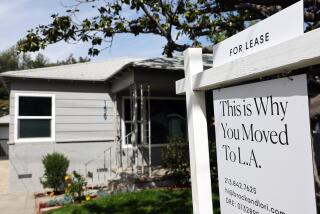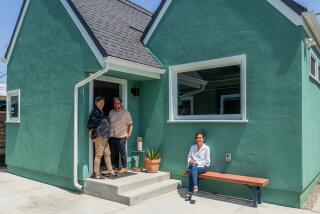Instead of Apartments : Elderly May Prefer Small Condo Houses
You can hardly have escaped noticing that builders are putting up more and more condominium complexes especially targeted to the elderly.
These communities serve the needs of many older people because they permit comfortable living without the necessity of taking care of the grounds. Some seniors, however, like something more like the houses they lived in all their lives--smaller and with less work--but without a drastic change in life style.
In some areas of the country, the needs of this group have been met with single-family dwellings that stand alone. The condominium concept remains. Associations of property owners contract for regular maintenance at a price somewhat less than if arranged individually.
âMore Personal Independenceâ
At least one housing expert predicts that the growing elderly population in the United States may soon lead to the widespread marketing of one-family houses designed for older buyers. He is Robert C. Dawson, chairman of Lawyers Title Corp., headquartered in Richmond, Va.
âThe one-family houses,â says Dawson, âallow more personal independence than is generally associated with a communal setting and provide special comfort, mobility and security features important to this age group.â
Dawson says a recent survey by the National Assn. of Realtors showed that 8% of all home purchasers and 12% of all repeat buyers are 55 years of age or older. That provides a substantial market for home builders and interior designers, he adds.
According to the U .S. Bureau of the Census, there are more than 28 million Americans who are 65 years of age or older. This number is expected to exceed 35 million by the year 2000. There now are more than 50 million persons 55 years of age or older, a figure expected to reach 59 million by the year 2000.
Dawson says houses for the elderly must include special features, such as electric sliding doors, eye-level cabinets and closets, easily accessible emergency call buttons in each major room, and modified furniture and bathroom fixtures that reduce the physical stress of day-to-day activities. He adds:
No-Frill Reception
âInstead of building upward to create an illusion of space, a home of this type might have a large and well-insulated combination sun room, dining room and living area to take maximum psychological advantage of natural sunlight and radiant heat.â
If the trend to one-family houses gains momentum, it will be interesting to see whether the elderly will accept no-frill or smaller residences. Some years ago, home builders unveiled their answer to the spiraling costs of shelter.
They built houses without frills: that is, those which did not include fireplaces, an elaborate layout, spacious yards, cedar-lined closets and the like. Many of them sold; many did not. Where buyers were given a choice, most opted for the amenities even though the price was higher. Within two years, builders got the message. Prospective purchasers were willing to pay more for what they wanted.
The chilly reception accorded no-frill houses by the general public may be even more pronounced for the elderly. Many are paying big prices for condominiums which meet their needs. This is the part of the elderly population that can handle a large down payment, not that which must struggle to make ends meet on a limited income, perhaps mostly from Social Security.
It is one of the peculiarities of the housing market that most buyers resist new ideas. But it is fairly certain the elderly will not resist features that make it easier for them to enjoy life in detached, one-story houses without all the physical chores that were necessary to maintain the houses they once had.
More to Read
Sign up for Essential California
The most important California stories and recommendations in your inbox every morning.
You may occasionally receive promotional content from the Los Angeles Times.






